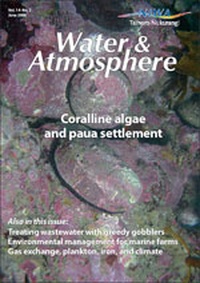Richard McKenzie's place in the sun
Perched atop the optics building at NIWA's Lauder campus, Richard checks the solar tracker. (Photo: Mike Kotkamp)
In the remote Manuherikia River valley of Central Otago, far from the air pollution of any sizable human population, sits NIWA’s world-renowned atmospheric research facility. The close-knit group of about 20 scientists, technicians, and support staff at Lauder takes advantage of the clean air to study the causes and effects of ozone depletion and of increasing greenhouse gases. Richard McKenzie has worked at Lauder for the better part of 25 years, beginning back when the lab was part of DSIR.
Richard’s science focuses on UV radiation. In April, he hosted the fourth in a series of international workshops on UV and its effects (see 'Update on UV'). The meeting highlighted some new concerns.
W&A – After years of hearing about the dangers of UV radiation, it now seems we need more of it! What gives?
Richard - Our high intensities of UV in the New Zealand summer cause skin cancer, so we need to continue to take precautions to protect ourselves then. But in winter our UV intensities are low, and some kiwis aren't getting enough of it to maintain healthy levels of vitamin D. It lasts in our bodies for only a few weeks. We can't get enough from our diet, and UV radiation is our major source. Vitamin D helps maintain bone strength, and seems to help fight off many diseases, including some forms of cancer, diabetes, multiple sclerosis, hypertension, and arthritis. Getting the right message out to the public will be a challenge.
W&A – How can we find out about UV in New Zealand?
Richard - There are now UV Index displays at pools and outdoor events around the country. You can look at the NIWA webpages for daily ozone and UV forecasts, and summaries of the previous day’s UV at a few sites in New Zealand and the Pacific. And the NIWA UV Atlas gives detailed UV information for the country in map form, with a user-friendly interface. We pass some of this information on to TV, radio, and newspapers via the MetService.
W&A – Did you always plan to be a physicist?
Richard - No, science was not a big issue for a kid growing up on the West Coast in the 1950s. In Reefton, and then later in Darfield in the early '60s, I was more interested in the normal outdoor things that boys get up to. I started to take a serious interest in science in my senior school years at Ashburton College. At University of Canterbury I discovered an interest in geophysics, and took an honours degree in physics. From there I went on to teachers' college at Christchurch. I had a short stint teaching at Kaiapoi High School, but for some reason my boss (still a good friend) was always trying to find me another job outside of teaching. That’s how I ended up in Fiji for three years, lecturing in physics at the University of the South Pacific and completing a Masters degree at the same time.
W&A – And then you fell for the bright lights of Lauder?
Richard - That’s right. I got a job with DSIR in their atmospherics laboratory. In those days the 10 or so staff were studying Aurora Australis and its effects. I lived with my family just a few metres from the lab, and many kilometres from anywhere else. After a few years I received an NRAC award to study for a DPhil in atmospheric physics at Oxford. When we returned to New Zealand three years later, we settled in Alexandra, 40 km from Lauder, where there were larger schools for the kids. Quite a few of us from NIWA commute from Alex. It’s a slice of paradise – the driest place in the country, hottest in summer, and invigoratingly cold in winter.
W&A – Speaking of cold, didn't you do Antarctic work around the same time the ozone hole was discovered?
Richard - Though I never got to Antarctica in person, we set up our experiment to measure NO2 there in 1981. That work turned out to be critical to understanding the causes of the Antarctic ozone hole, which was discovered a few years later. We were lucky to have been so closely involved in the ozone issue well before it became a hot topic.
W&A – In recent years, the Antarctic ozone hole has been decreasing. Does this mean that the crisis is over?
Richard – That’s the big question. The ozone hole varies a lot from year to year, but in the 1990s it was slightly worse than it has been recently. This is partly because in the '90s the atmosphere was still being influenced by the eruption of Mt Pinatubo, but also because atmospheric chlorine, which causes the problem, was close to its peak. Since then, the concentrations of ozone-depleting chemicals have been decreasing as a result of the Montreal Protocol. All other things being equal, a slow recovery in ozone would be expected, starting in the late 1990s. These issues are an important focus of my work with the UNEP Effects Panel and the WMO Assessment of Ozone Depletion. In New Zealand, ozone has been increasing over the last few years, as it has in other midlatitudes. The situation is complicated by other factors, such as interactions with climate change, so we can't be confident yet that the recovery seen so far will continue. And if it does, it would take decades to recover fully, and by that time the composition of the atmosphere will have changed a lot. Whatever happens, summertime UV intensities in New Zealand will remain high. Our peak values are about 40% more than those at comparable latitudes in the northern hemisphere.
You’ll find more about UV and ozone levels in New Zealand at: www.niwascience.co.nz/services/uvozone/



